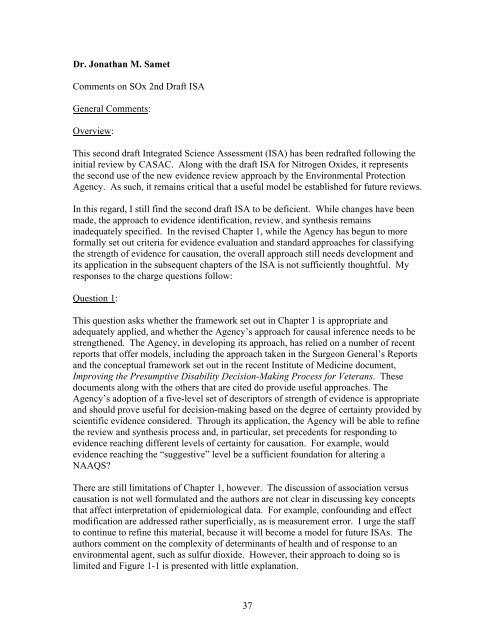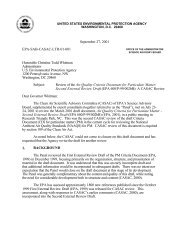(CASAC) Peer Review of EPA's Integrated Science Assessment
(CASAC) Peer Review of EPA's Integrated Science Assessment
(CASAC) Peer Review of EPA's Integrated Science Assessment
You also want an ePaper? Increase the reach of your titles
YUMPU automatically turns print PDFs into web optimized ePapers that Google loves.
Dr. Jonathan M. SametComments on SOx 2nd Draft ISAGeneral Comments:Overview:This second draft <strong>Integrated</strong> <strong>Science</strong> <strong>Assessment</strong> (ISA) has been redrafted following theinitial review by <strong>CASAC</strong>. Along with the draft ISA for Nitrogen Oxides, it representsthe second use <strong>of</strong> the new evidence review approach by the Environmental ProtectionAgency. As such, it remains critical that a useful model be established for future reviews.In this regard, I still find the second draft ISA to be deficient. While changes have beenmade, the approach to evidence identification, review, and synthesis remainsinadequately specified. In the revised Chapter 1, while the Agency has begun to moreformally set out criteria for evidence evaluation and standard approaches for classifyingthe strength <strong>of</strong> evidence for causation, the overall approach still needs development andits application in the subsequent chapters <strong>of</strong> the ISA is not sufficiently thoughtful. Myresponses to the charge questions follow:Question 1:This question asks whether the framework set out in Chapter 1 is appropriate andadequately applied, and whether the Agency’s approach for causal inference needs to bestrengthened. The Agency, in developing its approach, has relied on a number <strong>of</strong> recentreports that <strong>of</strong>fer models, including the approach taken in the Surgeon General’s Reportsand the conceptual framework set out in the recent Institute <strong>of</strong> Medicine document,Improving the Presumptive Disability Decision-Making Process for Veterans. Thesedocuments along with the others that are cited do provide useful approaches. TheAgency’s adoption <strong>of</strong> a five-level set <strong>of</strong> descriptors <strong>of</strong> strength <strong>of</strong> evidence is appropriateand should prove useful for decision-making based on the degree <strong>of</strong> certainty provided byscientific evidence considered. Through its application, the Agency will be able to refinethe review and synthesis process and, in particular, set precedents for responding toevidence reaching different levels <strong>of</strong> certainty for causation. For example, wouldevidence reaching the “suggestive” level be a sufficient foundation for altering aNAAQS?There are still limitations <strong>of</strong> Chapter 1, however. The discussion <strong>of</strong> association versuscausation is not well formulated and the authors are not clear in discussing key conceptsthat affect interpretation <strong>of</strong> epidemiological data. For example, confounding and effectmodification are addressed rather superficially, as is measurement error. I urge the staffto continue to refine this material, because it will become a model for future ISAs. Theauthors comment on the complexity <strong>of</strong> determinants <strong>of</strong> health and <strong>of</strong> response to anenvironmental agent, such as sulfur dioxide. However, their approach to doing so islimited and Figure 1-1 is presented with little explanation.37
















